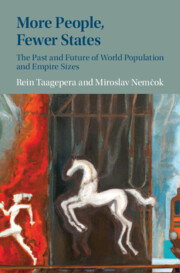Book contents
- More People, Fewer States
- More People, Fewer States
- Copyright page
- Contents
- Figures
- Tables
- Preface
- 1 More People and Yet Fewer States
- Part I World Population Growth
- Part II Empire Growth
- 4 From Populations to Empires and the Role of Technology
- 5 Empires
- 6 Talkers, Doers, Regulators, and Followers
- 7 From Pecking Order to Political Order
- 8 Runner Empires (−3000 to −600)
- 9 Early Rider Empires (−600 to +600)
- 10 An Apparent Dead End
- 11 Stirrup Empires (600 to 1200)
- 12 The Last Rider Empires (1200 to 1800)
- 13 Engineer Empires (From 1800 Onward)
- Part III Trends and Interactions
- Book Appendix: Chronological Table of Major State Sizes, −3500 to +2025
- References
- Index
4 - From Populations to Empires and the Role of Technology
from Part II - Empire Growth
Published online by Cambridge University Press: 21 June 2024
- More People, Fewer States
- More People, Fewer States
- Copyright page
- Contents
- Figures
- Tables
- Preface
- 1 More People and Yet Fewer States
- Part I World Population Growth
- Part II Empire Growth
- 4 From Populations to Empires and the Role of Technology
- 5 Empires
- 6 Talkers, Doers, Regulators, and Followers
- 7 From Pecking Order to Political Order
- 8 Runner Empires (−3000 to −600)
- 9 Early Rider Empires (−600 to +600)
- 10 An Apparent Dead End
- 11 Stirrup Empires (600 to 1200)
- 12 The Last Rider Empires (1200 to 1800)
- 13 Engineer Empires (From 1800 Onward)
- Part III Trends and Interactions
- Book Appendix: Chronological Table of Major State Sizes, −3500 to +2025
- References
- Index
Summary
We designate as an empire a state that stands out by area and population, as compared to most neighbors. The same population–technology interaction that enables world population to grow also enables states and then empires to form and expand, mostly by brutal force. Empires form where people are. The joint population share of the top five empires reached 50% of the world population by the year +1, and it did so on just 10% of the dry land area. The areas of top empires expanded in three phases, dependent on message speeds but also skills in delegation of power: Runner, Rider and Engineer Empires. The Rider age produced a new type of nomadic “area empires,” with low population density, in contrast with standard high-density “people empires.” The areas and populations of people empires tend to follow a square root relationship: Their share of world population is the square root of their share of dry land area.
Keywords
- Type
- Chapter
- Information
- More People, Fewer StatesThe Past and Future of World Population and Empire Sizes, pp. 47 - 59Publisher: Cambridge University PressPrint publication year: 2024

